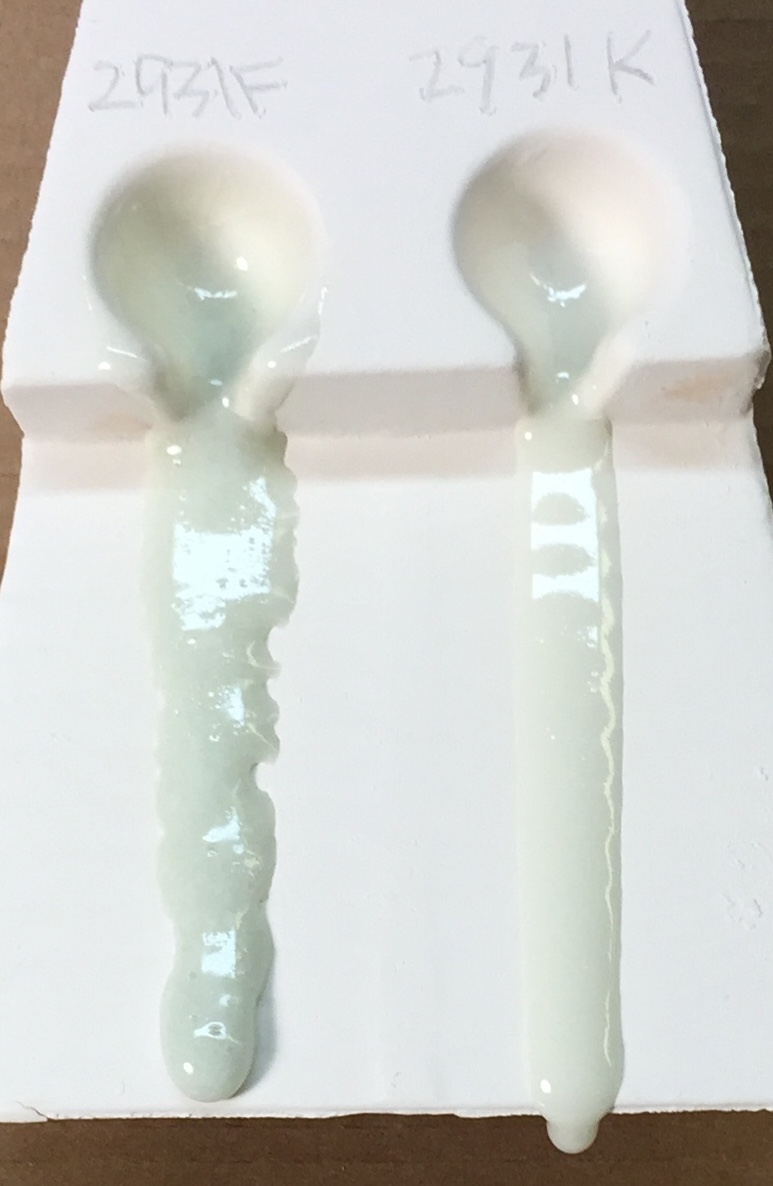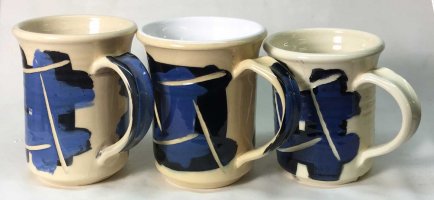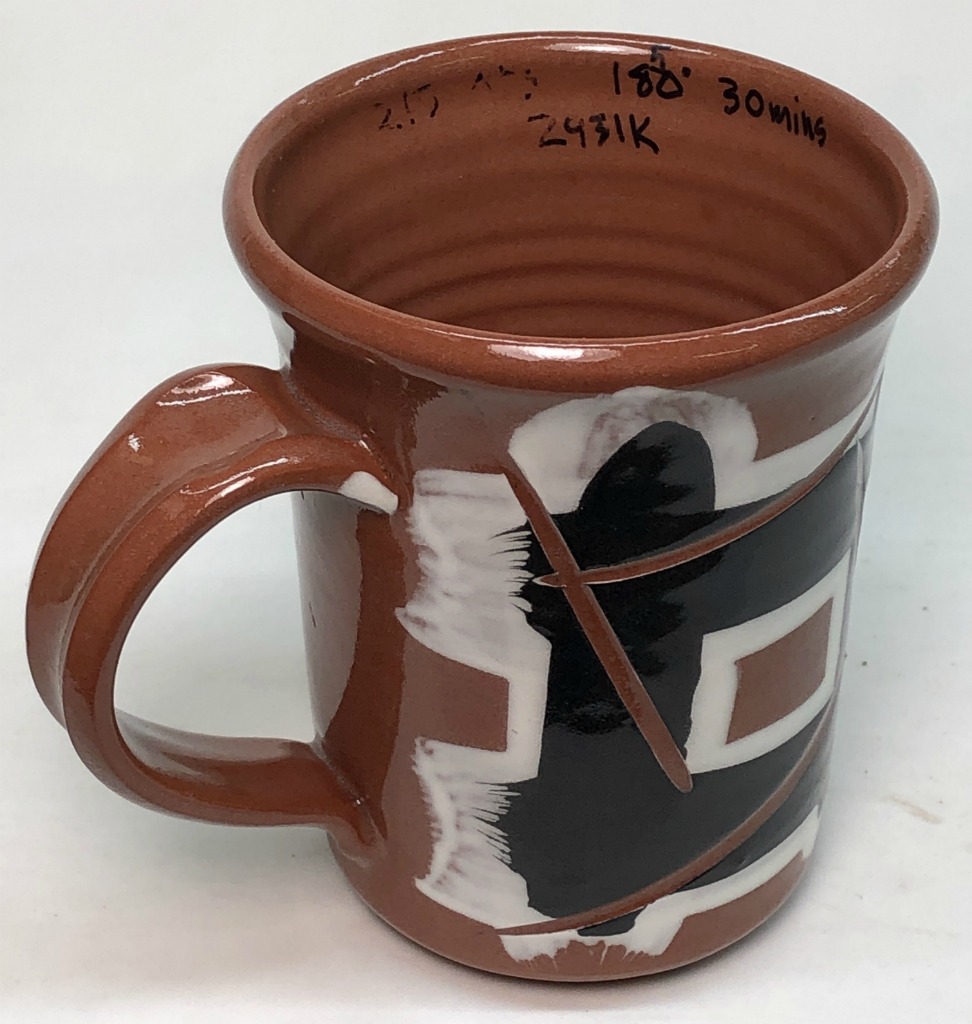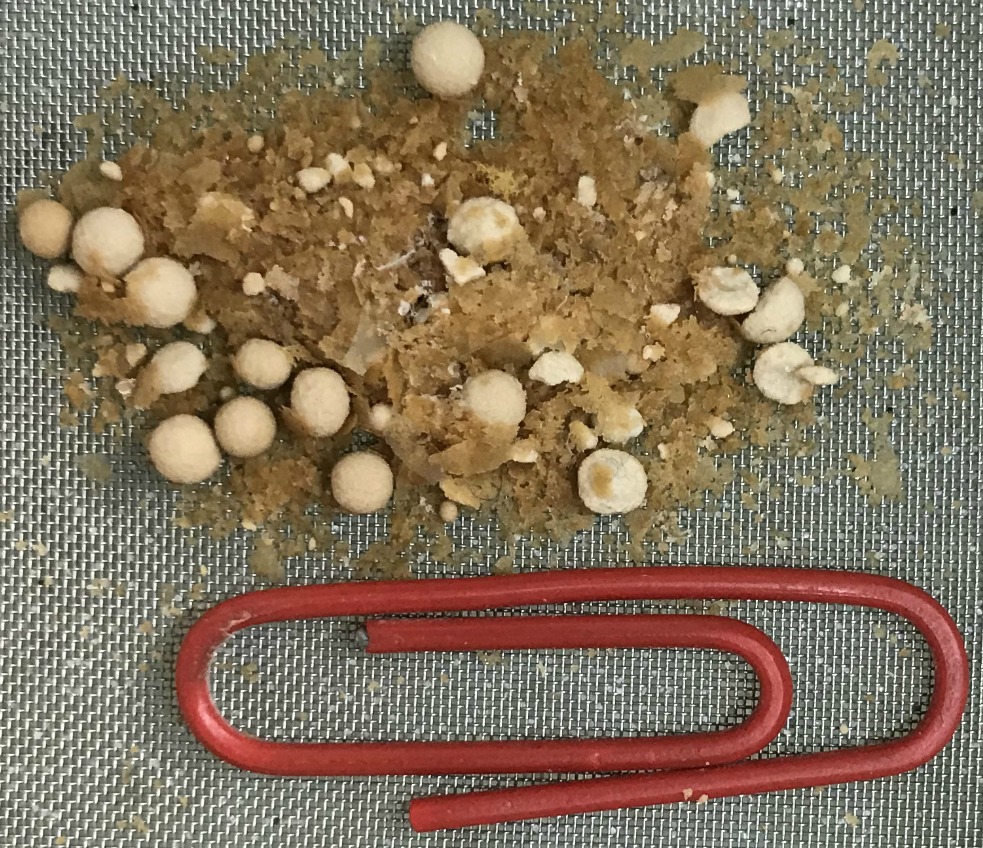Project Name
Entry level L215 slip-glaze system
Project Codenumber
UnAssigned
Notes
This project is seeking to produce an entry-level terracotta process (non-vitreous) where the slip and glaze fit well enough at cone 03 to make functional ware. The slip can be stained to produce a wide range of colors, the piece bisqued and then clear glazed for conde 03. A special firing schedule is needed to prevent clouding and glaze defects. For a clay body, use Plainsman L215.
Much work was required to find an engobe recipe that would fire bond well and be drying shrinkage, thermal expansion and quartz inversion compatible with the body.
This project is for cone 03, firing lower or higher takes the system into new dynamics that need to be tested.
Zero3 K Cone 03 Transparent Glaze
|
Code # G2931K |
| Materials | Amt | |
|---|---|---|
| Ferro Frit 3195 | 25.000 | 26.32% |
| Ferro Frit 3134 | 33.000 | 34.74% |
| EPK | 20.000 | 21.05% |
| Ferro Frit 3249 | 10.000 | 10.53% |
| Ferro Frit 3110 | 7.000 | 7.37% |
Total:95.00
Auto Unity Formula
|
Si:Al: 6.1:1 7.4 (Molar:7.5) 3.1 Cost 0.00 per kg |
Notes
This recipe improved on the popular Worthington Gerstley-Borate-based low fire clear recipe. It targeted cone 03 to work best on Zero3 stoneware and porcelain. To fire lower (cone 06-04), consider G1916Q (or derivatives) instead.
Unlike its Worthington Clear predecessor, this does not become a bucket of jelly, does not crack on drying, does not go on unevenly or the wrong thickness, does not cloud up with boron blue or micro-bubbles when fired (because it has lower CaO) when used on the types of bodies discussed below. It is crystal clear and super glassy at cone 03.
If you liked the variegated appearance of the GB version, titanium dioxide can be added to this to produce even better variegation. For darker color rutile with do the same.
Low fire bodies span a wide range of thermal expansions. While Worthington clear (an ancestor of this recipe) melts to a good clear, its thermal expansion was too low. This recipe, G2931K, raises thermal expansion (by adding Na2O). The thermal expansion of Zero3 stoneware and porcelain are about the middle of the range, and they develop good glaze:glaze interfaces, so this recipe fits them well.
This glaze shivers on high-talc bodies and can craze on zero-talc porous ones. This recipe has three variations we have worked with, one of higher expansion (G2931H) and one of lower expansion (G2931L). Keep in mind that adding zircon and stains changes expansion.
Dipping ware in Zero3 Transparent is just so much easier than trying to paint on commercial, slow-drying clears. For us it naturally gels to a creamy consistency at around 1.53 specific gravity (in our circumstances). However it goes on too thick at that high a value, we have found the best all-around performance at 1.43 with enough Epsom Salts to gel it back up to a creamy thixotropic consistency (a few grams per gallon).
Pay special attention to the drop-and-hold firing schedule, especially if your clay body is not fine-grained. Use 04DSDH as a model.
To mix up 5 Kg use about 4.5 kg of water to get 6.5 litres of dipping glaze. To make a brushing glaze: For each 100g of powder mix start with 125 water, 1.5 CMC gum and 1.5 Veegum and thoroughly mix in a kitchen blender (add water if it gels too much). We find the about 330g of powder produces a 500ml (about 1 pint) jar.
To make colored versions add stains as needed (if stains cause micro-bubbling or orange peel surface include 2-3% zircopax).
Batch Ticket Notes
These notes were entered in the notes panel under "Batch Ticket Notes"
Pictures
G2931K on Zero3 Stoneware

Fired cone 03. Body is Zero3 stoneware.
Surface is perfect, even where thick. Ultra clear.
Survived three boil:ice cycles and one 300F:ice cycle without crazing.
G2931F vs. G2931K on Polar Ice Low Fire

2931F was the Ulexite flused version of this recipe. The F survived three boil:ice cycles and 1 300F:ice cycle without crazing or shivering.
The K is slightly smoother, tiny dimples in the surface are fewer. It is also applied thicker.
G2931F vs G2931K fritted - terra cotta mugs cone 03

F was the Ulexite-fluxed version of this recipe.
G2931F vs G2931K flow test

These two recipes have the same chemistry, but K sources boron from frits rather than Ulexite. Notice how much less bubbles there are in the flow and how much more predictable the melting pattern is.
G2931F vs G2931K - Melted balls at cone 03

F, the Ulexite version, is obviously bubbling more, the percolation is causing the melt to spread out more on the tile. On the flow test is was less fluid.
Firing temperature is important for Zero3 glaze

This is G2931F on Plainsman Buffstone, L213, F100, L215. First column is cone 04, center is cone 03, right is cone 02. All exited the kiln without crazing except Buffstone at cone 04.
We subjected all of them to a 300F:IceWater thermal shock.
Buffstone crazed on all of them.
L215 and L212 Cone 04 crazed.
L213 was good but later the glaze was found to be under excessive compression, subject to shivering over underglazes.
At cone 02 there are some dimples and defects.
Three low fire bodies that need three clear glazes

Because of glaze fit. Left: Plainsman Buffstone, contains no talc, fires buff. Center: L212 (about 25% talc). Right: L213 (about 45% talc, fires whiter). Talc raises thermal expansion. The centre glaze is G2931K (Insight-live reports COE 7.4), it fits L215 (also Zero3 porcelain and stoneware). It crazes on Buffstone and shivers on L213 and L212. G2931L has lower expansion (to work on zero-talc porous bodies). G2931H is higher (for talc bodies like L213).
G2931K glaze precipitates things on storage

G2931K On L212 after a year

Some crazing starting.
K on L215 at cone 04

The thicker version is clouding. The thinner one has micro-pinholes. It needs a higher temperature.
G2931K o L215 - Cone 03, thick application

G2931K on L215 - Cone 03 fired in 30 minutes

Very transparent. No crazingafter many months.
G2931K on L215 - Cone 06

Milky (because cone 06 is underfired for this glaze). But only a little crazing after a year.
G2931K running on Zero3 Casting

This happened at cone 03 and 04. The G3879 (left) did not run. For some reason G2931K easy applies to thickly on this body.
This 1000 gram batch of glaze powde

This 1000 gram batch of glaze powder screened 80 mesh immediately after making, and allowed to sit for 3 months prior to usage.
The material in photo was screened out once again after the 3 month time lapse, (80 mesh once again).
The largest balls are approx. 2.5 mm. in diameter, and when these particles were screened out, and still perhaps slightly wet?, they were quite easy to break in half with your fingernail.
G1916Q (left) vs G2931K (right) at cone 04

On a terra cotta body, the G1916Q is performing better, there are less micro bubbles.
URLs
How to tune the thixotropy of a glaze
How to convert a d..o a brushing glaze
Typecodes
ST-Untitled typecode
Alternate Code Number:GS04-1
XML (to paste into Insight)
<?xml version="1.0"?> <recipes version="1.0" encoding="UTF-8"> <recipe name="Zero3 K Cone 03 Transparent Glaze" id="95671" key="XAo5TxJ2" date="2023-05-03" typecodes="ST" codenum="G2931K" picturebasename=""> <recipelines> <recipeline material="Ferro Frit 3195" amount="25.000" tolerance=""/> <recipeline material="Ferro Frit 3134" amount="33.000" tolerance=""/> <recipeline material="EPK" amount="20.000" tolerance=""/> <recipeline material="Ferro Frit 3249" amount="10.000" tolerance=""/> <recipeline material="Ferro Frit 3110" amount="7.000" tolerance=""/> </recipelines> </recipe> </recipes>
Born: 2006-03-16, Modified: 2023-05-03 20:54:14
Zero3 Engobe Recipe
For use with the Zero3 body and glaze
|
Code # L3685U1 |
Location BOX48 |
| Materials | Amt | |
|---|---|---|
| Nepheline Syenite | 10.000 | 9.80% |
| Pioneer Kaolin | 42.000 | 41.18% |
| Ferro Frit 3110 | 25.000 | 24.51% |
| Silica | 20.000 | 19.61% |
| National Standard Bentonite | 5.000 | 4.90% |
Total:102.00
Notes
The Zero3 Engobe finds its inspiration in the ceramic tile industry. Thousands of tons of white engobe are applied to tiles made from red or brown burning bodies, after pressing, to prepare them for glazing. The white surface enables the use of glazes of any color.
This engobe is not required in the Zero3 system, but like tile, it is employed for practical reasons. A typical use case for functional ware is application to inside food surfaces at leather hard state (and covering with the clear transparent Zero3 glaze after bisque firing). Or, as in tile, application to the red-burning body, by dipping or painting, to create a white base onto which coloured underglaze decoration is done. If you are using this engobe on another clay body, especially if not firing to cone 03, do an EBCT test to be sure they are compatible (have the same firing shrinkage), adjust the frit percentage as needed.
This is an engobe, it must be applied at stiff leather-hard stage (if you apply it to dry or bisque it will flake off). It will rewet pieces and they will require significant time to re-stiffen to the same state. Even coverage can normally only be achieved by preparing a slurry of the correct rheological properties and dipping or pouring. It is vital that you have a good mixer and can effectively measure specific gravity. To mix this use the process described on the “Engobe” glossary page at the Digitalfire Reference Library. A paint-on version of this can be made by adding 500g powder engobe to a mix of 400g water and 75g of Laguna Gum Solution (makes 1 pint). This produces brush-stroke coverage, which can be very attractive.
A drop or two of Dettol might be needed to store this for long periods (to prevent bacteria or mold).
Recipe info: The silica helps match body thermal expansion and glaze fit. The frit makes the fired hardness of the engobe more closely match the body. Nepheline Syenite is included as a filler. The bentonite is needed for good adhesion to the leather hard body and for dry hardness.
Pictures
Engobe applied to leather-hard mug

This was done by simply filling and rotate-pouring the engobe, then pressing the lip into it. Since the engobe gels the mug could be turned over immediately without creating any drips.
Notice that the outer surface of the handle has been waxed to slow down its drying. This is because the engobe rewets the mug body, thereby setting it behind the handle. This mug has thin wall so this this rewet adds a day to the production process. This next day the brushwork is done on the outside.
Zero3 body with G2931F Zero3 glaze

The F version of the glaze employs Ulexite to source the boron (instead of frits). These Zero3 stoneware mugs were fired to cone 03 with underglazes. The right mug has the Zero3 engobe inside (under the glaze).
Pulling badly on L212 on EBCT at cone 04

Amaco white engobe vs. L3685U 15% white stain

Even with 15% white stain this engobe is not nearly as white (in the raw state) as the Amaco version. Need to experiment more with whiter kaolins and opacifer additions.
Variations
6100 - Red
1400 powder, 1067 water, 5.6 Darvan produced 1.52 SG. Too runny, took alot of epsom salts. Perhaps water could be reduced. Pulling badly at L212 on EBCT test.
Testdata
EBCT - Engobe Body Compatibility Test
| MATA | MATB | BNDR | BNFR | BCON | |
| 1 | engobe | L212 | 1.6mm | 15mm/engobe | 06 |
| 2 | engobe | L212 | 1.5mm | 10mm | 04 |
| 3 | engobe-brown | L212 | 3.3 | 03 |
XML (to paste into Insight)
<?xml version="1.0"?> <recipes version="1.0" encoding="UTF-8"> <recipe name="Zero3 Engobe Recipe" keywords="For use with the Zero3 body and glaze" id="93335" key="2PZLkqJ9" date="2021-02-01" codenum="L3685U1" location="BOX48"> <recipelines> <recipeline material="Nepheline Syenite" amount="10.000" tolerance=""/> <recipeline material="Pioneer Kaolin" amount="42.000" tolerance=""/> <recipeline material="Ferro Frit 3110" amount="25.000" tolerance=""/> <recipeline material="Silica" amount="20.000" tolerance=""/> <recipeline material="National Standard Bentonite" amount="5.000" tolerance=""/> </recipelines> </recipe> </recipes>
Born: 2014-11-04, Modified: 2021-02-01 16:04:10
Firing Schedule Name
Cone 03 hold-rise-drop-hold
Degrees (Fahrenheit or Celcius)
F
Schedule Type
Rate
Start Time and Temperature
8:01 am at 80F
Program
| Step | Degrees/Hr | Temperature Monitor |
Hold Time |
Accumulated hrs:min |
Time | Note |
|---|---|---|---|---|---|---|
| 1 | 400 | 240 | 60 | 1:24 | 9:25 am | |
| 2 | 350 | 1850 | 30 | 6:00 | 2:01 pm | |
| 3 | 108 | 1950 | 10 | 6:55 | 2:56 pm | |
| 4 | 500 | 1850 | 30 | 7:07 | 3:08 pm |
Notes
Used to glaze fire Zero3 porcelain and stoneware. However, there is a caution about bisquing these frit-containing bodies: They will vitrify in a typical firing, you must reduce the temperature to around 1500F (if ware is not absorbent enough fire lower). Note: this schedule is for the glaze firing, the previous two sentences simply referenced what is needed for the bisque.
This can start and finish more than once in a working day. Step 2 can often be done as fast as your kiln will go (cold-to-cold in three hours is possible).
The soak at 240F does not fracture ware even though it is above the boiling point of water. We find this is needed to be sure ware is sufficiently dry to withstand the rapid ascent to 1850. If your ware is thicker a slower ascent may be needed.
The 1850 soak on the way up clears the clouds of microbubbles. The 1850 soak on the way down heals the defects (blisters, pinholes) because the increasing viscosity is enough to overcome the surface tension holding bubbles from breaking).
It may be necessary to alter the last step if any imperfections are present. Try dropping to 1800 or 1750 and holding there. An additional step could be added to cool at 100F/hr down to 1500.
